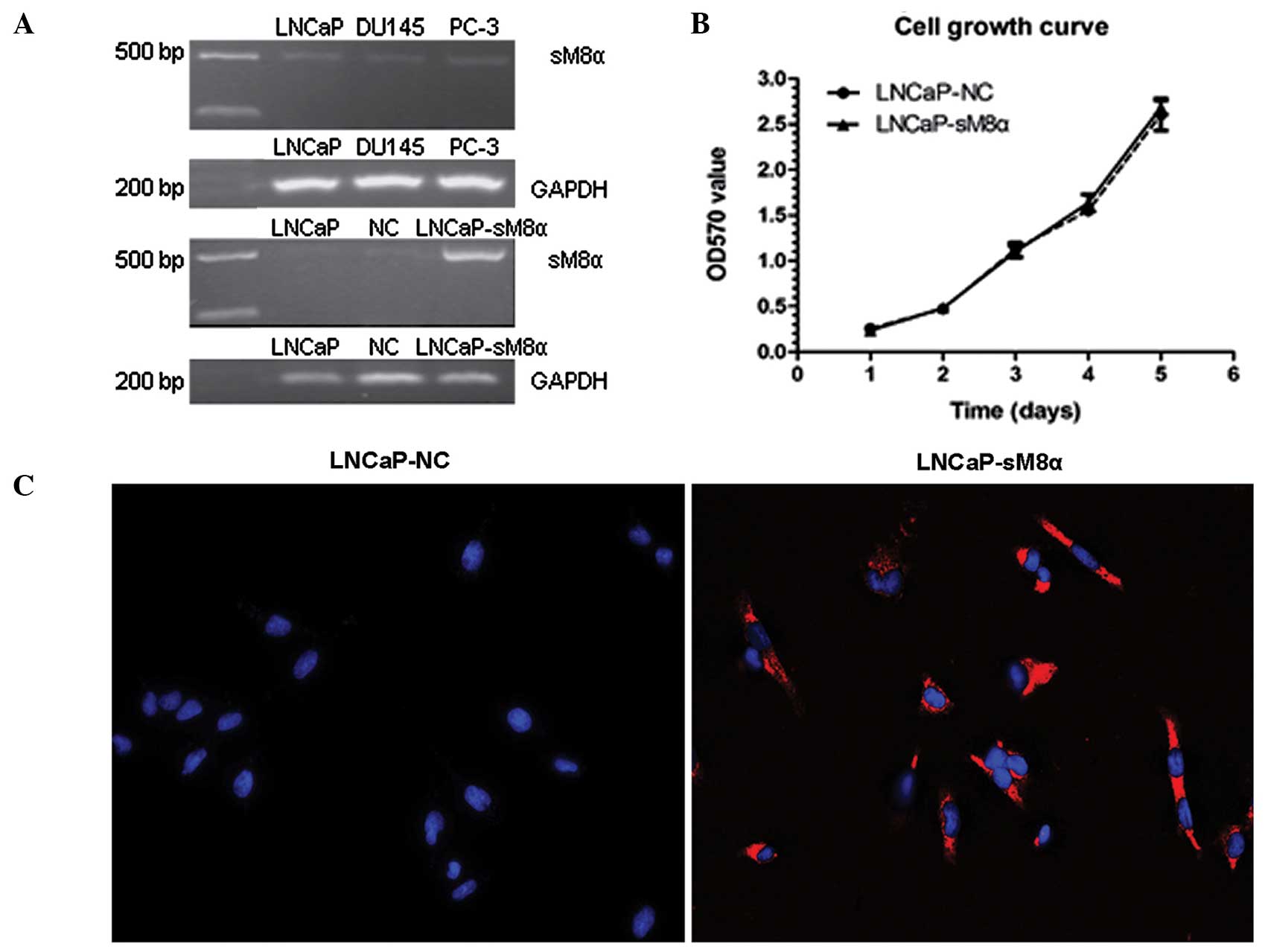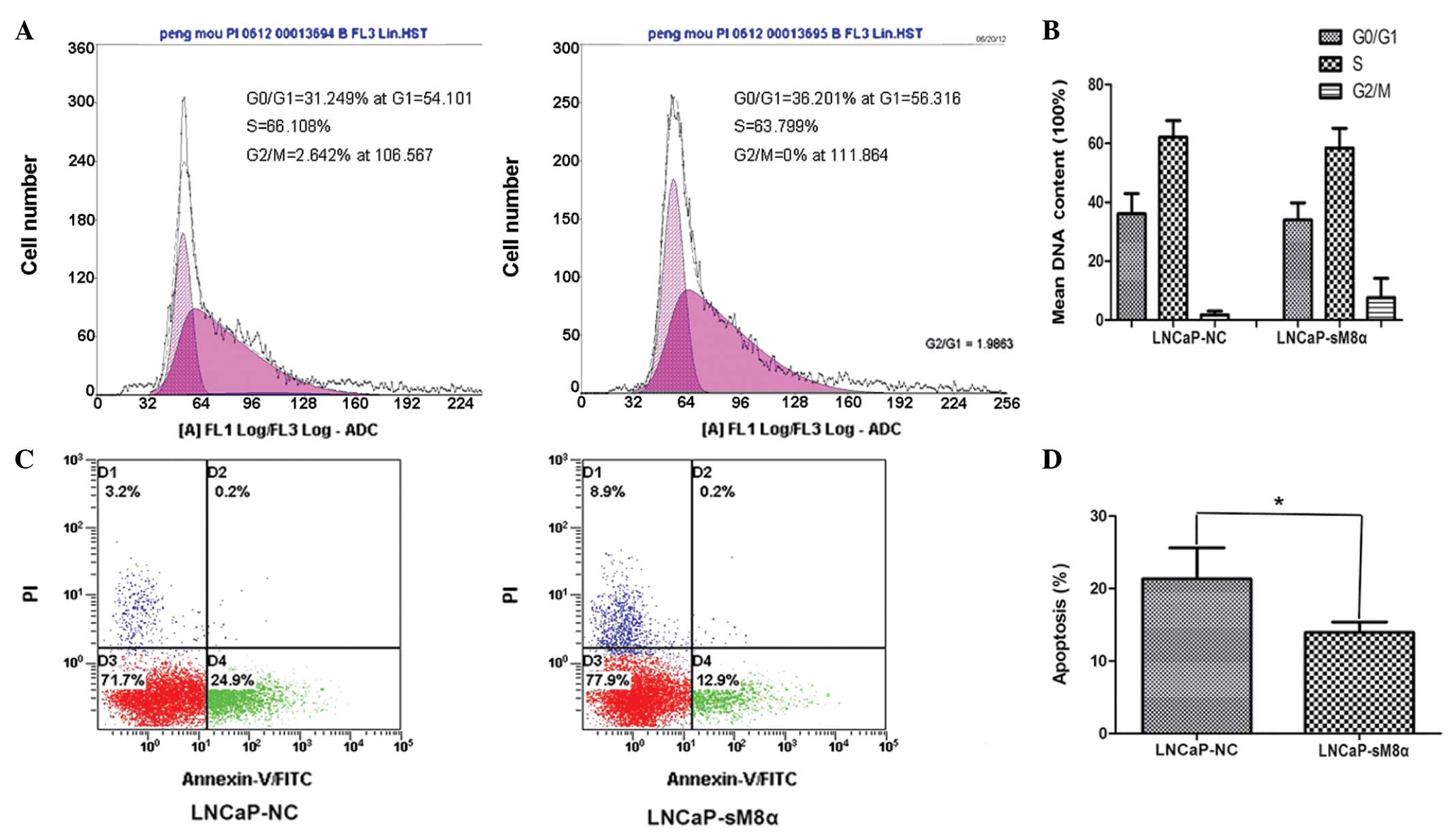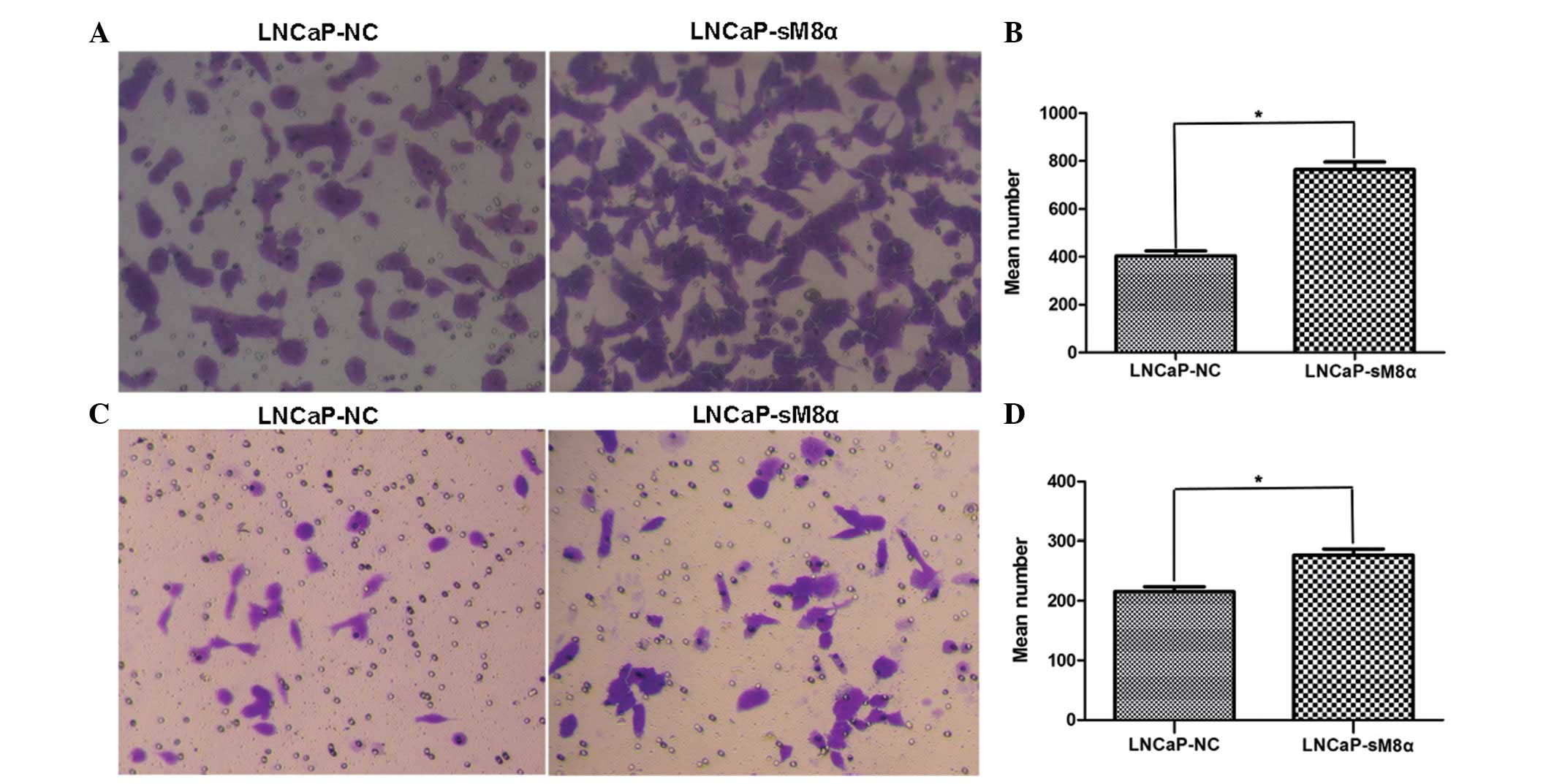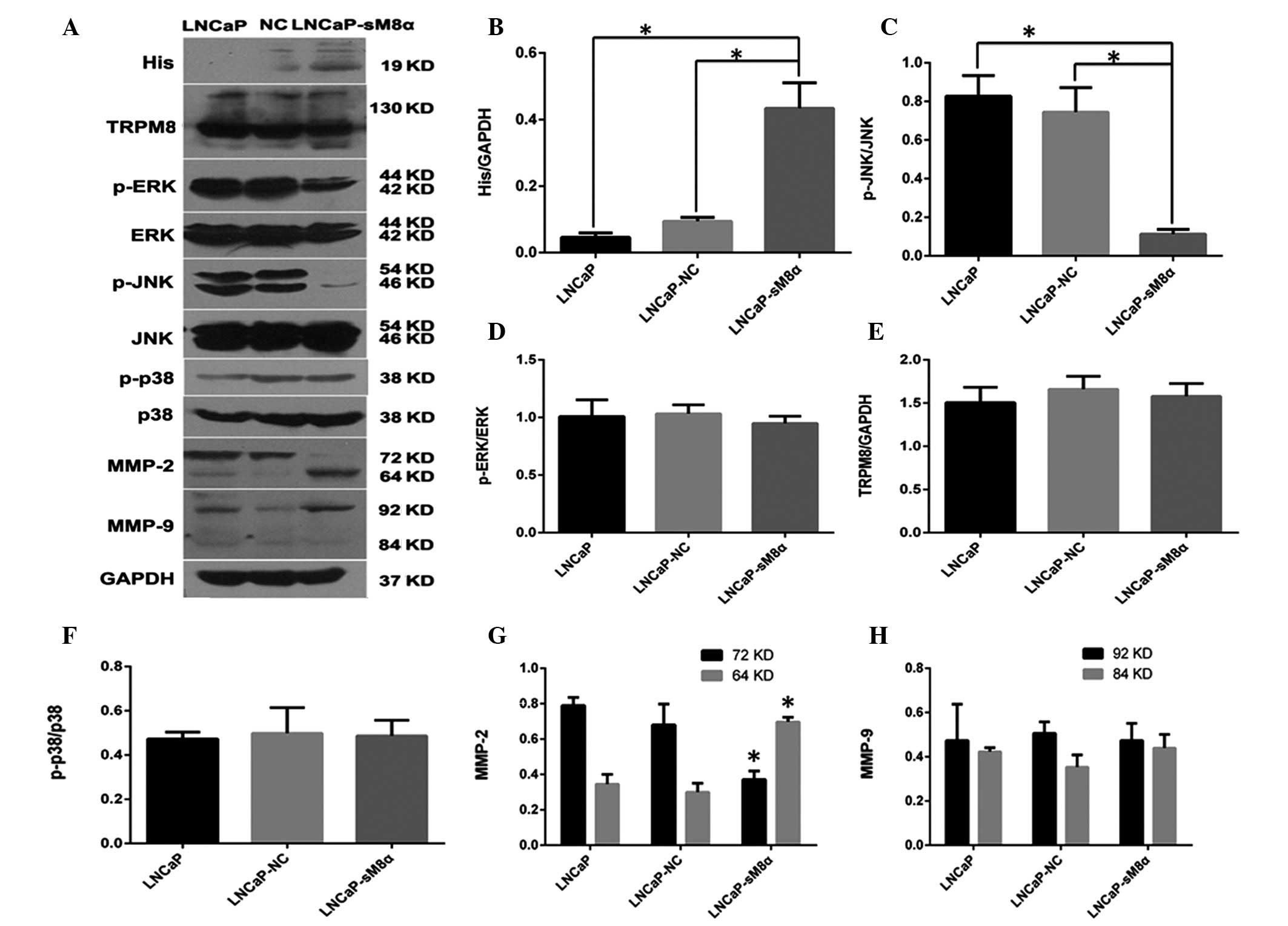Overexpression of short TRPM8 variant α promotes cell migration and invasion, and decreases starvation-induced apoptosis in prostate cancer LNCaP cells
- Authors:
- Published online on: June 16, 2015 https://doi.org/10.3892/ol.2015.3373
- Pages: 1378-1384
-
Copyright: © Peng et al. This is an open access article distributed under the terms of Creative Commons Attribution License.
Abstract
Introduction
Prostate cancer is the most commonly diagnosed type of carcinoma in men in western industrialized countries (1). Despite initially responding to androgen-deprivation therapy, prostate cancer typically becomes resistant and evolves into recurrent androgen-independent cancer following approximately one year of treatment (2). The mechanism for how this resistance develops is unclear and the development of novel therapeutic strategies for the treatment of androgen-independent prostate cancer are required.
Transient receptor potential melastatin 8 (TRPM8) is a type of Ca2+ permeable cation channel that is potentially associated with tumorigenesis and tumor progression (3). Yang et al (4) transfected TRPM8 into androgen-independent PC-3 prostate cancer cells, and determined that overexpression of TRPM8 inhibits the proliferation and malignant progression of PC-3 cells. A study conducted by Zhang and Barritt (3) revealed that TRPM8 has a vital role in Ca2+ homeostasis in prostate epithelial cells, in addition to being required for cell survival. Therefore, TRPM8 may have an effect on the growth and malignant progression of prostate cancer.
Alternative splice variants contribute to biological complexity and diversity by coding for functional or nonfunctional protein isoforms. TRPM8 isoforms generated by alternative mRNA splicing are expressed in different tissues, such as human lung tissue (5,6) and certain types of prostate cancer (7). The functions of various TRPM8 isoforms have previously been described in a number of studies (8,9). For example, short TRPM8α (sM8α) and short TRPM8β (sM8β) code for N-terminal fragments of the full-length TRPM8 channel, and regulate TRPM8 activity by stabilizing the closed state of the channel, thus, reducing its activity and cold sensitivity (8). Furthermore, inhibition of TRPM8 activity by sM8β, heat or chemical blockers revealed common mechanisms for regulating the single-channel kinetics (9). However, the majority of previous studies reported the functions of short TRPM8 isoforms in human embryonic kidney (HEK) 293 cells. Therefore, research regarding the function of short TRPM8 isoforms in prostate cancer cells is required to elucidate their role in the progression of prostate cancer.
The aim of the present study was to detect the expression of sM8α in various prostate cancer cell lines; to investigate the role of sM8α expression on prostate cancer LNCaP cell line proliferation, apoptosis, migration and invasion; and to examine the involvement of the mitogen activated protein kinase (MAPK) signaling pathway.
Materials and methods
Cell culture
Human prostate carcinoma LNCaP, DU145 and PC-3 cells were purchased from the American Type Culture Collection (Manassas, VA, USA) and cultured in RPMI 1640 medium (Gibco Life Technologies, Grand Island, NY, USA) containing 10% fetal bovine serum (FBS; Gibco Life Technologies), 100 µg/ml streptomycin sulfate and 100 U/ml penicillin G sodium (G4003; Guge Biotech, Wuhan, China). Cells were maintained in a humidified incubator with 5% CO2 at a temperature of 37°C.
Reverse transcription-polymerase chain reaction (RT-PCR) for sM8α
Total RNA was extracted from prostate carcinoma LNCaP, DU145 and PC3 cells using TRIzol reagent (Invitrogen Life Technologies, Carlsbad, CA, USA). A total of 2 µg RNA was reverse transcribed (Beijing TransGen Biotech Co., Ltd., Beijing, China) into complementary (c)DNA at 42°C using oligo(dT) primers and murine leukemia virus reverse transcriptase (TransScript First-Strand cDNA Synthesis SuperMix; Beijing TransGen Biotech Co., Ltd.), followed by PCR using the 2xTransTaq High Fidelity(HiFi) PCR SuperMix II(−dye) (Beijing TransGen Biotech Co., Ltd). The PCR primers were as follows: Forward, 5′-ATACTCGAGATGGAAGGCACCCAGATCAACCAAAGTGAGAAATGGAACT-3′ and reverse, 5′-ATAGAATTCCTAATGATGATGATGATGATGGCAGACCTCCTCCTGTCCCA-3′ for sM8α; and forward, 5′-ACGGATTTGGTCGTATTGGG-3′ and reverse, 5′-CGCTCCTGGAAGATGGTGAT-3′ for glyceraldehyde phosphate dehydrogenase (GAPDH). For PCR, 2 µl cDNA template of the three prostate cancer cell lines were respectively added to a PCR mixture (Beijing TransGen Biotech Co., Ltd.) and then ddH2O was added up to a final volume of 20 µl. The DNA amplification conditions were as follows: 95°C for 10 min; 35 cycles of 95°C for 30 sec, 60°C for 30 sec and 72°C for 1 min; followed by 72°C for 10 min. The length of the sM8α PCR product was 534 bp. Furthermore, the PCR product contained two restriction enzyme sites [XhoI (Takara Biotechnology Co., Ltd., Dalian, China) in the 5′ extremity and EcoRI (Takara Biotechnology Co., Ltd.) in the 3′ extremity] and a His tag in the 3′ extremity. GAPDH was used as the housekeeping gene, with the following amplification conditions: 95°C for 10 min; 28 cycles of 95°C for 30 sec, 56°C for 30 sec and 72°C for 30 sec; followed by 72°C for 10 min. The length of the GAPDH PCR product was 214 bp. All PCR products were analyzed by gel electrophoresis and DNA sequencing.
Plasmid construction
A pcDNA3.1(−) eukaryotic expression clone vector (Invitrogen Life Technologies) was used in the present study. The PCR product contained the gene of interest, a His tag and XhoI and EcoRI restriction enzyme sites. The plasmid and PCR product were digested by XhoI and EcoRI prior to isolation by DNA gel extraction (Axygen, Hangzhou, China). Then, the digested plasmid and PCR product sequences were linked using T4 DNA ligase (Thermo Fisher Scientific Inc., Beijing, China), and transformed into DH5α cells (Biovector NTCC, Inc., Beijing, China) for synthesis of the pcDNA3.1(−)-sM8α-His plasmid. The plasmid was sequenced and found to contain no mutations.
Cell transfection for stable cell clone
LNCaP cells were plated into a six-well plate at a density of 105 cells/well, and transfected at ~90–95% confluence with the recombinant pcDNA3.1(−)-sM8α-His and pcDNA3.1(−) negative control (NC) plasmids using 10 µl Lipofectamine 2000 (Invitrogen Life Technologies, Carlsbad, CA, USA), according to the manufacturer's instructions. Stably transfected clones were selected using G418 (Sigma-Aldrich, St Louis, MO, USA) at a concentration of 700 µg/ml. Colonies were identified using RT-PCR and western blot analysis. In the present study, LNCaP-sM8α cells refer to LNCaP cells transfected with and overexpressing His-tagged sM8α, and LNCaP-NC cells refer to LNCaP cells transfected with empty vector.
Cell proliferation
Cell proliferation was detected by performing a 3-(4,5-dimethylthiazol-2-yl)-2, 5-diphenyltetrazolium bromide (MTT) assay. Cells were seeded in 96-well plates at a density of 1×103 cells per well and were incubated for 1–5 days. Subsequently, 20 µl MTT (concentration, 5 mg/ml) was added to each well and the plate was incubated for 4 h. The liquid was removed from each well and replaced with 150 µl DMSO. The optical density (OD) value of each well was measured at a wavelength of 570 nm using an MD2 Microplate Reader (Molecular Devices, Sunnyvale, CA, USA).
Quantum dots (QDs)-based immunofluorescent imaging
LNCaP-sM8α and LNCap-NC cells were plated on 12-mm coverslips and incubated overnight, prior to being fixed with 1% neutral formaldehyde at room temperature for 10 min. To prepare samples for QD-based immunofluorescent imaging, cells were first blocked with 2% w/v bovine serum albumin (BSA) for 30 min at 37°C and then incubated with the primary anti-His-tag antibody for 4 h at 37°C. The cells were incubated with secondary antibody (QDs-605) for 2 h at 37°C following an a second blocking step with 2% BSA for 30 min. Cells were subsequently incubated with DAPI (5 µg/ml) for 3 min at room temperature to stain the nuclei. The samples were washed with Tris-buffered saline and examined under an Olympus BX51 fluorescence microscope equipped with an Olympus DP72 camera (Olympus Corporation, Tokyo, Japan). The QDs-605 and DAPI were excited by ultraviolet light (wavelength, 388 nm) (10).
Flow cytometry
LNCaP-NC and LNCaP-sM8α cells were prepared for cell cycle and apoptosis assays (kit from Kaiji Biotechnology Co., Ltd., Nanjing, China), according to the manufacturer's instructions. Briefly, the cells were fixed with 70% ethanol overnight at a temperature of 4°C, washed with phosphate-buffered saline and stained with propidium iodide. Subsequently, the cell cycle stage was determined and analyzed by performing flow cytometry. To evaluate apoptosis, cells were seeded in complete culture medium for 24 h and then incubated in culture medium containing 1% fetal bovine serum (FBS) for an additional 48 h. The percentage of apoptotic cells were determined using flow cytometry, according to the manufacturer's instructions (Kaiji Biotechnology Co., Ltd.). Details of the flow cytometry experiments have been previously described (4).
Cell migration and invasion assays
To assay cell migration, 2×104 cells suspended in 200 µl RPMI-1640 medium without FBS were seeded onto the fibronectin-coated polycarbonate membrane of a Transwell® insert [Becton Dickinson Medical Devices (Shanghai) Co., Ltd., Shanghai, China]. A volume of 600 µl RPMI-1640 with 10% FBS was added as a chemoattractant in the lower chamber. Following incubation for 12 h at 37°C in a 5% CO2 atmosphere, the Transwell insert was washed with PBS and the cells on the top surface of the insert were removed with a cotton swab. Cells adhering to the lower surface were fixed with methanol for 10 min, stained with 0.1% Giemsa solution for 10 min, thrice-washed with PBS and finally air-dried. Five predetermined fields (magnification, x200) were counted using a fluorescence microscope (BX51; Olympus Corporation, Tokyo, Japan). All assays were independently repeated in triplicate. The cell invasion assay procedure was similar to that for cell migration, except the Transwell membranes were pre-coated with 50 µg/µl Matrigel® (BD Biosciences, Franklin Lakes, NJ, USA) and the cells were incubated for 48 h at 37°C in a 5% CO2 atmosphere. Cells adhering to the lower surface were counted in the same manner as for the cell migration assay.
Western blot analysis
Protein expression levels of the sM8α-His fusion protein, TRPM8, matrix metalloproteinase (MMP)-2, MMP-9, MAPK signaling pathway proteins [p38, c-Jun N-terminal kinase (JNK) and extracellular signal-regulated kinase 1/2 (ERK1/2)] and GAPDH were assayed using western blot analysis. Equal quantities of protein (30 µg) were separated by 10% sodium dodecyl sulfate-polyacrylamide gel electrophoresis and then transferred to electrochemiluminescence nitrocellulose membranes (GE Healthcare Life Sciences, Piscataway, NJ, USA). Primary antibodies against human TRPM8 (rabbit polyclonal; catalog no. ACC-049; Alomone Labs, Jerusalem, Israel; 1:500 dilution), MMP-2 (rabbit monoclonal IgG; catalog no. 13132; Cell Signaling Technology, Inc., Danvers, MA, USA; 1:1,000 dilution), MMP-9 (rabbit monoclonal IgG; catalog no. 13667, Cell Signaling Technology, Inc.; 1:1,000 dilution), GAPDH (rabbit polyclonal IgG; catalog no. sc-25778, Santa Cruz Biotechnology, Inc., Dallas, TX, USA; 1:1000 dilution), MAPK family [rabbit anti-p38, ERK1/2 (p44/42) and JNK (catalog no. 9926), and phospho (p-)p38, p-ERK1/2 and p-JNK (catalog no. 9910); Cell Signaling Technology, Inc.] and His-tag (mouse monoclonal IgG2a; catalog no. D291-3, Medical & Biological Laboratories Co., Ltd., Nagoya, Japan) were applied overnight at 4°C. Polyclonal goat anti-rabbit (catalog no. sc-2005; 1:5,000 dilution) and goat anti-mouse (catalog no. sc-2004; 1:5,000 dilution) IgG horseradish peroxidase-conjugated (Santa Cruz Biotechnology, Inc.) secondary antibodies were then applied for 2 h at 37°C. Protein bands were visualized using an ECL Western Blotting kit (Guge Biotech, Wuhan, China). The results of western blot were analyzed by Image-Pro Plus 6.0 (Media Cybernetics, Inc., Rockville, MD, USA) and the integrated optical density values were normalized to GAPDH, which was the loading control. The procedure was performed as previously described (4) and each experiment was repeated three times with similar results.
Statistical analysis
SPSS software for Windows (version 13.0; SPSS, Inc., Chicago, IL, USA) was used to perform all statistical analyses. All data are presented as the mean ± standard error of the mean. Statistical analyses were performed using the unpaired t-test, with P<0.05 considered to indicate a statistically significant difference.
Results
Expression of sM8α in three prostate cancer cell lines and its effect on cell proliferation
sM8α mRNA expression levels were investigated in three prostate cancer cell lines (LNCaP, DU145 and PC-3) using RT-PCR, revealing that the expression level of sM8α was low in all three lines. Following stable transfection of sM8α into LNCaP cells, sM8α mRNA expression levels were detected in LNCaP, LNCaP-NC and LNCaP-sM8α cells. As expected, expression of sM8α in the LNCaP-sM8α cells was high compared with the LNCaP-NC cells (Fig. 1A). Cell growth curves for the LNCaP-sM8α and LNCaP-NC cells were generated using OD data obtained on days 1–5. No significant difference in cell proliferation was identified between the LNCaP-sM8α and LNCaP-NC cells (P>0.05; Fig. 1B).
Subcellular location of the sM8α-His fusion protein in stably transfected LNCaP cells
QD-based immunofluorescent imaging revealed clearly observable red immunofluorescence in the majority of LNCaP-sM8α cells examined, indicating expression of the sM8α-His fusion protein. Furthermore the sM8α-His fusion protein was visualized in cytoplasm. By contrast, immunostaining did not detect a red immunofluorescence signal for the sM8α-His fusion protein in LNCaP-NC cells; instead, only DAPI-stained blue fluorescent nuclei were observed (Fig. 1C).
Flow cytometry analysis of cell cycle distribution and apoptosis
The results demonstrated that there were no significant differences in the cell cycle between LNCaP-NC and LNCaP-sM8α cells (Fig. 2A and B). The effect of the sM8α-His fusion protein on the apoptosis of transfected LNCaP cells was also investigated. Following incubation in RPMI 1640 with 1% FBS for 48 h, sM8α-His fusion protein was identified to exhibit a significant antiapoptotic effect on LNCaP cells. The percentage of apoptotic LNCaP-sM8α cells was significantly lower than the proportion of apoptotic LNCaP-NC cells (13.93±0.84 vs. 21.33±2.47%; P<0.05; Fig. 2C and D).
Enhanced cell migration and invasion in LNCaP-sM8α cells
High rates of cell migration and invasiveness are characteristics of cancer cells, indicating and contributing to malignancy (11). Therefore, cell migration and invasion are common targets of anticancer treatment strategies. Cell counts of the lower surfaces of the Transwell membranes revealed that the migration of LNCaP-sM8α cells was significantly increased following 12 h of incubation when compared with LNCaP-NC cells (P<0.05; Fig. 3A and B). Subsequent analysis of the cell count data revealed a significant increase in the invasiveness of LNCaP-sM8α cells compared with LNCaP-NC cells (P<0.05; Fig. 3C and D). Furthermore, western blotting (Fig. 4) of MMP-2 and MMP-9 indicated that overexpression of sM8α may increase the migration and invasion in LNCaP cells via significantly increasing the proportion of active, 64-kDa MMP-2 (Fig. 4A, G and H).
p-JNK/MAPK signaling pathway may be important in antiapoptosis
The MAPK signaling pathway is an important signaling pathway, and is involved in the regulation of cell proliferation and apoptosis (12). Therefore, western blotting was performed to detect possible changes in the expression levels of proteins in this signaling pathway. The expression of p-JNK was significantly reduced compared in LNCaP-sM8α cells with the control (P<0.05; Fig. 4A and C), indicating its possible involvement in the antiapoptotic mechanism of mS8α. By contrast, p38 and ERK1/2 expression exhibited no significant change in expression between LNCaP-sM8α cells and control cells (P<0.05; Fig. 4A, D and F). Changes in the expression level of full-length TRPM8, which is known to be regulated by sM8α and sM8β in terms of cold sensitivity and channel activity in HEK293 cells (9), were not observed in the LNCaP-sM8α and LNCaP-NC cells (P>0.05; Fig. 4A and E).
Discussion
Alternative splice variants are the product of mRNA post-transcriptional processing and have an important effect on the biological behavior of cancer cells. Thus far, the splice variants of numerous ion channels, including TRP channels, have been described (13,14). The role of these TRP-channel splice variants in biological behavior is becoming increasingly clear; however, at present, there is little information regarding the functions of TRPM8 isoforms in the field of carcinogenesis and cancer progression. Therefore, the role of sM8α, which encodes the N-terminal fragment of TRPM8, was investigated in prostate cancer cells in the present study.
At least three short TRPM8 isoforms, each exhibiting their own pathophysiological functions, have been reported in previous studies. Sabnis et al (6) reported that the full-length TRPM8 transcript was absent in human lung epithelial cells and identified a novel truncated TRPM8 variant that was selectively expressed as a modulator of respiratory physiology in cold air. Furthermore, Bidaux et al (8) reported the following two novel short splice variants of TRPM8, which were cloned from prostate cancer cells, using a model of HEK293 cells: sM8α and sM8β. The results demonstrated that the two variants were in a closed configuration with the C-terminal tail of the full-length TRPM8 channel, resulting in stabilization of its closed state, and reducing its cold sensitivity and activity. Additionally, Fernández et al (9) identified that, in addition to increased temperature, or treatment with BCTC or clotrimazole, short sM8-6 isoforms of TRPM8 inhibited the channel. The present study investigated sM8α by generating an expression vector containing only the sM8α coding sequence and a His-tag, encoding a protein of 19 kDa. This was different to the sM8α splice variant reported by Bidaux et al (8), which encoded two protein isoforms of 6 and 18 kDa. This discrepancy may result from the existence of a regulatory sequence in the sM8α plasmid allowing for further splicing. Subsequent QDs-based immunofluorescent imaging revealed the sM8α-His fusion protein located in the cytoplasm of the LNCaP cells.
Apoptosis is a fundamental cellular process regulated by precise gene expression (15). In the present study, LNCaP cell apoptosis was induced by starvation and it was identified that overexpression of sM8α could significantly reduce the percentage of apoptotic LNCaP cells. MMP-2 and MMP-9 are key proteins in cancer progression, and are involved in the initial breakdown of collagen and basement membrane components during tumor growth and invasion (16). The present study used Transwell chambers to simulate the basement membrane for migration and invasion, and the results indicated that overexpression of sM8α, through activation of MMP-2, may increase the migration and invasion of LNCaP cells.
The activity of TRPM8 is regulated by a number of cellular signaling pathways, most notably by phosphoinositides and the activation of phospholipase C (17). However, the cellular signaling pathways regulated by sM8α in prostate cancer cells are unclear. The three major MAPKs (p38, JNK, and ERK1/2) are signal transducers involved in a broad range of prostate cancer cell functions, including survival, apoptosis and cell differentiation (18). The present study demonstrated a role for the MAPK signaling pathway in the regulation of sM8α. Although the ERK1/2 and p38 signaling pathways did not appear to be regulated by sM8α, significantly reduced activation of p-JNK was identified in LNCaP-sM8α cells. We hypothesize that this may be associated with the reduction of LNCaP-sM8α cell apoptosis.
The physiological roles of short TRPM8 isoforms require further investigation. For example, the functions of short TRPM8 isoforms are unclear in prostate cancer cells not expressing full-length TRPM8 and it remains to be elucidated whether short TRPM8 isoforms can influence the release of Ca2+ from the endoplasmic reticulum. Furthermore, additional evidence is required to determine if short TRPM8 isoforms negatively regulate TRPM8 in non-cancerous prostate cells (including normal prostate and benign hyperplasia of the prostate tissue), as well as in cancerous prostate cells.
In conclusion, the present study demonstrated that LNCaP cells express low levels of sM8α. The results indicate that overexpression of sM8α has no detectable affect on the proliferation of LNCaP cells; however, sM8α overexpression did appear to increase cell migration and invasion by activation of MMP-2. Furthermore, the antiapoptotic effect of sM8α may be regulated by activation of p-JNK in LNCaP cells. Additional studies of short TRPM8 isoforms should be performed to gain a greater understanding of the functions of the TRPM8 channel.
Acknowledgements
The present study was supported by the Program of Chinese National Natural Science Fund (grant no. 81172734).
References
|
Spies E, Reichardt W, Alvarez G, et al: An artificial PAP gene breaks self-tolerance and promotes tumor regression in the TRAMP model for prostate carcinoma. Mol Ther. 20:555–564. 2012. View Article : Google Scholar : PubMed/NCBI | |
|
Feldman BJ and Feldman D: The development of androgen-independent prostate cancer. Nat Rev Cancer. 1:34–45. 2001. View Article : Google Scholar : PubMed/NCBI | |
|
Zhang L and Barritt GJ: Evidence that TRPM8 is an androgen-dependent Ca2+ channel required for the survival of prostate cancer cells. Cancer Res. 64:8365–8373. 2004. View Article : Google Scholar : PubMed/NCBI | |
|
Yang ZH, Wang XH, Wang HP and Hu LQ: Effects of TRPM8 on the proliferation and motility of prostate cancer PC-3 cells. Asian J Androl. 11:157–165. 2009. View Article : Google Scholar : PubMed/NCBI | |
|
Sabnis AS, Reilly CA, Veranth JM and Yost GS: Increased transcription of cytokine genes in human lung epithelial cells through activation of a TRPM8 variant by cold temperatures. Am J Physiol Lung Cell Mol Physiol. 295:L194–L200. 2008. View Article : Google Scholar : PubMed/NCBI | |
|
Sabnis AS, Shadid M, Yost GS and Reilly CA: Human lung epithelial cells express a functional cold-sensing TRPM8 variant. Am J Respir Cell Mol Biol. 39:466–474. 2008. View Article : Google Scholar : PubMed/NCBI | |
|
Bidaux G, Flourakis M, Thebault S, et al: Prostate cell differentiation status determines transient receptor potential melastatin member 8 channel subcellular localization and function. J Clin Invest. 117:1647–1657. 2007. View Article : Google Scholar : PubMed/NCBI | |
|
Bidaux G, Beck B, Zholos A, et al: Regulation of activity of transient receptor potential melastatin 8 (TRPM8) channel by its short isoforms. J Biol Chem. 287:2948–2962. 2012. View Article : Google Scholar : PubMed/NCBI | |
|
Fernández JA, Skryma R, Bidaux G, et al: Short isoforms of the cold receptor TRPM8 inhibit channel gating by mimicking heat action rather than chemical inhibitors. J Biol Chem. 287:2963–2970. 2012. View Article : Google Scholar : PubMed/NCBI | |
|
Liu XL, Peng CW, Chen C, Yang XQ, Hu MB, Xia HS, Liu SP, Pang DW, Li Y, et al: Quantum dots-based double-color imaging of HER2 positive breast cancer invasion. Biochem Biophys Res Commun. 409:577–582. 2011. View Article : Google Scholar : PubMed/NCBI | |
|
Meng F, Henson R, Wehbe-Janek H, Ghoshal K, Jacob ST and Patel T: MicroRNA-21 regulates expression of the PTEN tumor suppressor gene in human hepatocellular cancer. Gastroenterology. 133:647–658. 2007. View Article : Google Scholar : PubMed/NCBI | |
|
Kim EK and Choi EJ: Compromised MAPK signaling in human diseases: An update. Arch Toxicol. Feb 18–2015.(Epub ahead of print). View Article : Google Scholar | |
|
Frühwald J, Camacho Londoño J, Dembla S, et al: Alternative splicing of a protein domain indispensable for function of transient receptor potential melastatin 3 (TRPM3) ion channels. J Biol Chem. 287:36663–36672. 2012. View Article : Google Scholar : PubMed/NCBI | |
|
Chu X, Tong Q, Wozney J, et al: Identification of an N-terminal TRPC2 splice variant which inhibits calcium influx. Cell Calcium. 37:173–182. 2005. View Article : Google Scholar : PubMed/NCBI | |
|
Goldar S, Khaniani MS, Derakhshan SM and Baradaran B: Molecular Mechanisms of Apoptosis and Roles in Cancer Development and Treatment. Asian Pac J Cancer Prev. 16:2129–2144. 2015.PubMed/NCBI | |
|
Schütz A, Schneidenbach D, Aust G, Tannapfel A, Steinert M and Wittekind C: Differential expression and activity status of MMP-1, MMP-2 and MMP-9 in tumor and stromal cells of squamous cell carcinomas of the lung. Tumour Biol. 23:179–184. 2002. View Article : Google Scholar : PubMed/NCBI | |
|
Yudin Y and Rohacs T: Regulation of TRPM8 channel activity. Mol Cell Endocrinol. 353:68–74. 2012. View Article : Google Scholar : PubMed/NCBI | |
|
Rodríguez-Berriguete G, Fraile B, Martínez-Onsurbe P, Olmedilla G, Paniagua R and Royuela M: MAP Kinases and Prostate Cancer. J Signal Transduct. 2012:1691702012.PubMed/NCBI |













